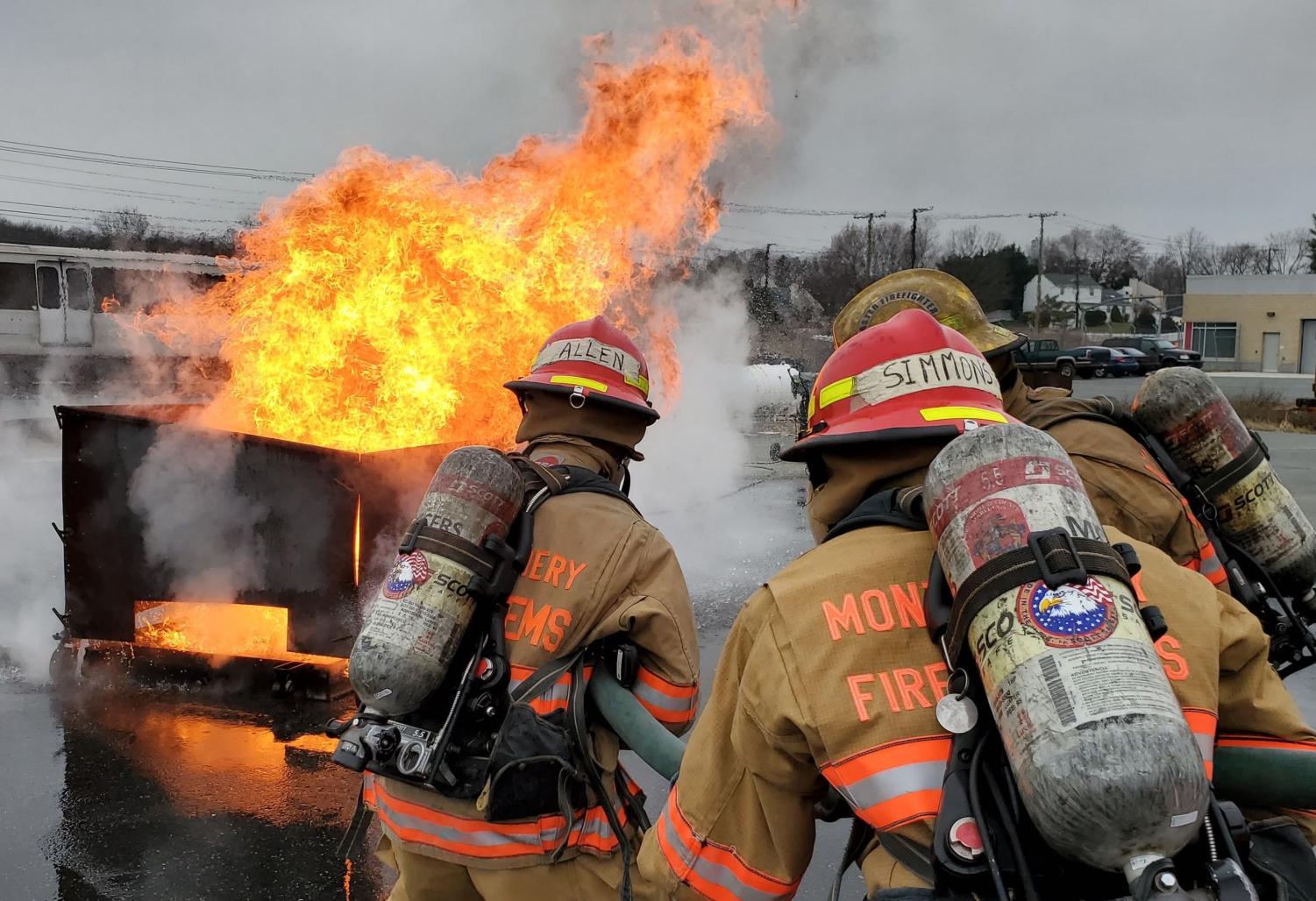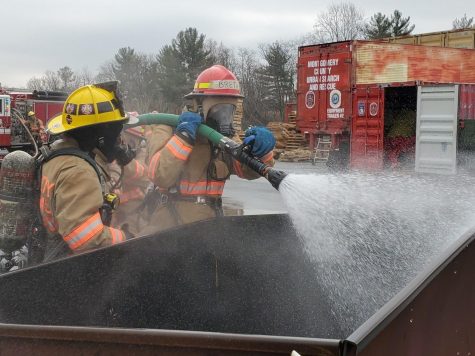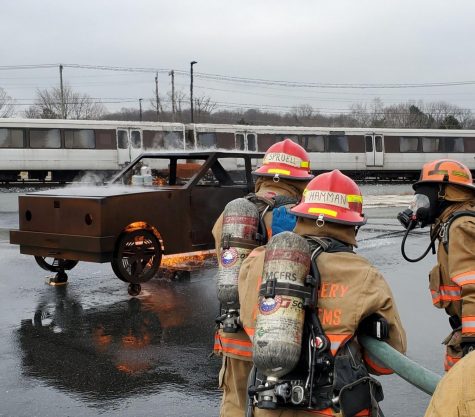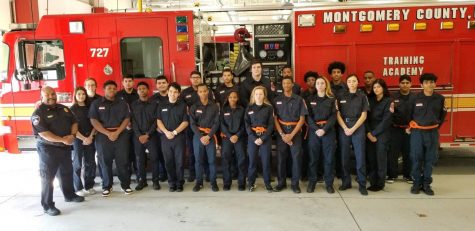
Why did you join the Black and White?
Journalism is really fun and I wanted to learn and share information with students
What's your favorite song?
It changes weekly, but currently Heat Waves by Glass Animals


March 22, 2020
During junior Stella Hamman’s first day at the Montgomery County Fire Rescue Service Training Academy, she lined up military-style with other teenage cadets in the engine bay, the section of the station that holds all the ambulances and vehicles. Instructors placed hefty bags full of hoses and gear in front of her and the other cadets, and throughout the tour of the facility, they each had to carry one of the extremely heavy bags by themselves.
“It was a big eye-opener,” Hamman said.
Hamman decided to join the program after attending an informational meeting at the Academy in February 2019. Hamman wanted to explore options to make her school day less routine and more unconventional, she said. At the meeting, instructors showed her and other potential cadets a typical classroom and the gym and spoke about what new cadets should expect.
“I got to swing a sledgehammer and I was like, oh my God, I want to do this,” she said.
Since that first day, Hamman has learned how to use an app to identify what materials large trucks are carrying in case of spillages or crashes, communicate locations in high-pressure situations using codes and wield tools such as a halligan which can pry open doors, cut through walls, and punch holes in metal.
Every day, Hamman leaves Whitman at 10:00 a.m. after her English 11, precalculus and physics classes. She drives a half an hour to Rockville, where she takes the bus for another half an hour to Montgomery Village. There, she takes classes at the Montgomery County Fire Rescue Service Training Academy, which cadets call “the Academy.”
Students come to the Academy from across the county, including Damascus, Clarksburg, Gaithersburg, Northwest and Seneca Valley High Schools. At the Academy, cadets do practicals — real-life simulations — as well as lecture-based studies, which can include 200-slide presentations about hazardous materials. When cadets complete the two-year program, Maryland will certify them to become firefighters and EMTs in 48 states.
They also have personal training days where they have to flip tires, do push-ups and swing hoses against the floor to build upper-body strength. Cadets have to carry ropes on them at all times; they also learn how to forcibly enter a room, properly place ladders, spray hoses and put on all their gear in under two minutes.
At the Academy, there are two 13-person cadet classes for a total of 26 cadets. Typically, firefighters work in 24-hour shifts with a two-day break, so all the Academy instructors are off-duty firefighters. Instructors can be demanding, but they know how their class learns best, Hamman said.
“We’ve seen some [of our instructors] on the side of the road as we’re driving by,” Hamman said. “We scream at them. It’s so much fun.”
Junior Jason Bretz, who attends the Academy and is in the same class as Hamman, also volunteers at the Cabin John Volunteer Fire Department on the weekends. Although the majority of calls to the station are for EMTs, Bretz “rode-along” in a firetruck once; he had to put up caution tape when electrical wires went down, which are extremely dangerous when exposed.

On Saturdays, senior Marin Johnson, another volunteer firefighter, usually volunteers from 7:00 a.m. to 7:00 p.m.. Johnson leaves school every day after fifth period and volunteers for around 35 hours a week. But Johnson isn’t a cadet at the Academy; instead, she received her volunteer firefighter certification at the Academy over the summer, which involved training for 40 hours per week.
“It was one of the best experiences of my life. I absolutely loved it,” Johnson said. “I look back on it fondly, but while I was in those moments, I was absolutely dying. The heat was horrible — it was like 110 degrees outside — and we were in 80 pounds of gear.”
Johnson started volunteering at the fire station as soon as she turned 16 years old, she said. Johnson wants to become a trauma surgeon, so she planned to take the EMT classes over the summer. But when she applied for the class, there weren’t any spots available.
“I’d already cleared my summer for the EMT class, and it was too late to plan anything else,” she said. “So I decided to take the fire class and do that over the summer, and I completely fell in love with it.”
She still took the EMT class afterward, but mostly because Montgomery County requires firefighters to be EMT certified to go into a fire. Since then, Johnson has been on the scene of car crashes and domestic violence, she said.
“It’s eye-opening to experience death and tragedy in this new way where I’m looking at this person, and they’re dead, but I have absolutely no connection to them,” Johnson said.
While still in training, though, cadets don’t encounter the real-life experiences Johnson has; instead, they practice for them. At the Academy, Hamman has had two “burns.” In the world of the Academy, burns aren’t physical — they’re simulations where cadets attempt to subdue or observe a controlled fire. For their first burn, cadets head to the Academy at 7:00 a.m., where they crowd into a makeshift crate and observe the different stages of fire as smoke billows over their heads. During their second burn, they have to try to shut down the controlled fires. Sometimes, when they mishandle the hoses, the ceiling sets on fire. Two cadets have to manage the hose because of the knockback, which is a force that results from the water quickly rushing out of the hose.
For burns and real-life situations, there’s a rule: two in, two out. That refers to the notion that firefighters should never go into a fire or situation alone, Bretz said.
“You have to trust your partner,” Bretz said. “You have to trust that he’s going to put that out and that you have his back holding that hose with him.”
Though they didn’t know one another before the program, the cadets in Hamman and Bretz’s class have become a tight-knit group, Hamman said; they see each other every day and learn each other’s strengths and weaknesses. Lieutenant Richard Tatum, the high school cadet coordinator, is like the class’ dad, Hamman said. Although the class is close now, it didn’t start that way, Tatum said.
“At the beginning of the year, students were looking out for themselves,” he said. “Now, they’re thinking about their team or family.”
Hamman remembers an argument she had early in the program, when another cadet, whom she has since become extremely close with, started yelling at her unpromptedly, she said.
“All my friends were coming up and were like, you have no right to yell at her,” Hamman said. “They were defending me.”
But recently, when the cadet Hamman had argued with had to drop out of the program due to a lack of credits for high school, Hamman cried.
“We’re just doing all that we can to keep each other there,” she said.
During the summer, Johnson also became close to her classmates. In one exercise, her partner passed out while they were trying to carry a 200-foot hose — which weighs over 150 pounds — up a flight of stairs and into a bedroom to put out a fire.
“One of my instructors, my mentors, was like, ‘okay, you know what you need to do now. You need to finish it by yourself.’ I absolutely thought I couldn’t do it,” Johnson said.
But thanks to the encouraging yells of her mentors and the supportive environment, she was able to succeed, she said. Johnson has become close friends with her mentors at the station, too. Most of her superiors and co-workers are middle-aged with kids.
“It’s a different dynamic,” Johnson said. “I get to be friends with and have these relationships with people who are different from me — people that are older than me and come from a different background.”

Despite the close bonds between many mentors and cadets, some sexism still pervades in firefighting, Hamman said. Hamman is one of just three girls in her class and sometimes she feels like her gender causes the more-traditional instructors to underestimate her.
Some of the instructors can be patronizing, especially when one called her “sweetie,” she said. Another time, a female instructor told her that she should act differently to better represent women. Hamman’s experience represents a nationwide lack of representation: In 2017, only 7% of firefighters were female across the nation, according to the National Fire Protection Association.
Despite this, there’s still a feeling of community throughout the department. Tatum described it as a family and a brotherhood.
“You always have a circle of people who are there for you,” Hamman said. “We all want each other to succeed.”
They even have “study sessions,” despite coming from all over Montgomery County. They argue like “siblings” and have a group chat, Hamman said.
Respect and trust are key to succeeding in the Academy, Tatum said. The Fire Department is paramilitary, meaning they have a chain of command and a hierarchical rank structure. Cadets and instructors alike address cadets by their last names, and cadets have to address adults by their rank and last name or “sir” and “ma’am.” This intense atmosphere has shaped Hamman to be more respectful, she said.
“When a superior walks in — a Lieutenant, Captain, anything, even your instructor — you have to get up and say ‘room,’” Hamman said. “We have one designated person in each class who always watches [the door].”
Discipline is an integral part of the Academy’s ethos: If one person is missing a part of their uniform, all students in the class have to do 20 push-ups. When Hamman dyed her hair blonde in May last year, she was unaware of the Academy’s hair dyeing requirements. However, she luckily chose a natural color — if it was an unnatural color, it wouldn’t have been allowed.
Hamman isn’t sure of what she wants to do after high school. She would like to take a gap year in Ecuador, she said. She’s also interested in working at a hospital. Next year, as part of the program, she’ll learn EMT skills which will help prepare her for medical work.
When Bretz was little, he wanted to be a pilot. Now, he’d like to be a firefighter or continue swimming in college, he said. He likes that the Academy helps him have a career right after high school, even if he doesn’t choose to pursue it, he said.
When Johnson was looking at colleges, she always checked to see if they had a fire station where she could work. She would like to continue volunteering, at least as a part-time job, for the rest of her life, she said.
Firefighting has changed her view of the world because she sees accidents firsthand, Johnson said. She’s witnessed the fallout of car crashes on the Beltway, and she’s seen a lot of accidents that resulted from drunk driving. Cases where drivers make bad decisions, “where no one needs to die,” are the most heartbreaking, she said.
“There was a whole car full of young men [who] claimed they were driving to play soccer,” Johnson said. “But they were all very, very intoxicated, and they collided with a car full of a family, and thankfully no one was hurt. It’s always what could’ve happened.”

Firefighting has opened up a new avenue for Bretz, Hamman and Johnson to learn from and potentially pursue as adults. They all also hope to stay in touch with their class after they graduate, they said.
“[The Academy] taught me to believe in myself more than I have,” Hamman said. “It’s given me more confidence to be like, ‘well, okay, you haven’t done that yet. There’s a first for everything.’”
